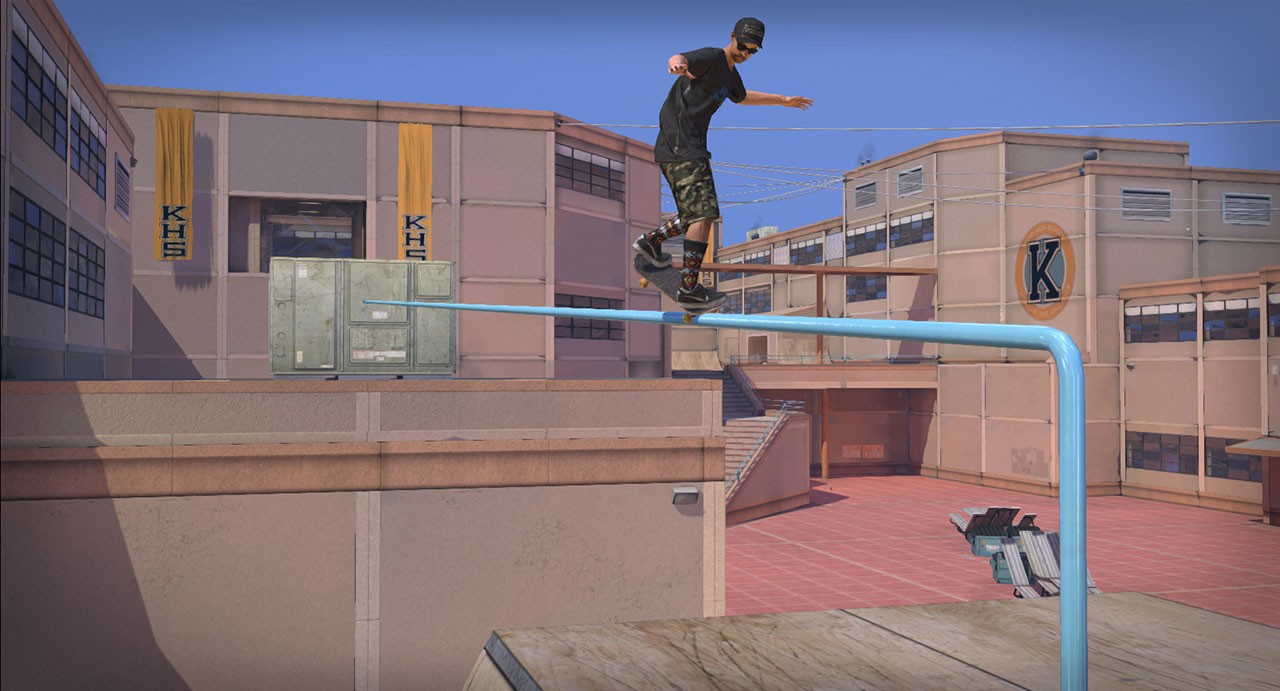Postscript is Cameron Kunzelman’s weekly column about endings, apocalypses, deaths, bosses, and all sorts of other finalities.
I associate the Tony Hawk skateboarding video game franchise with stress. They’re games that demand a lot from their players. The basic operation of a skateboard is hard, and despite the decidedly arcadey feel of the games, they capture something fundamental about the challenging do-it-over-again feel of actual skateboarding.
Videos by VICE
I’ve been playing my PS2 copy of Tony Hawk’s Pro Skater 4 for the past week or so, and it’s forced me to come to grips with something that is basically unspeakable in the video game community: I think that the Tony Hawk franchise, at its peak of Pro Skater 3 / Pro Skater 4 / Underground, is a better skateboarding game than the much-beloved Skate series.
Pro Skater vs Skate might seem, at first, like some mere forum argument, the Superman vs Batman of skateboarding video games, but I’d like to argue that each of their interpretations of what skateboarding is means something in the context of video game depictions of the activity. At their best, the Pro Skater entries are deeply technical games that feature missions and challenges that are often more like puzzles than freeform activities. Before 2003’s Tony Hawk’s Underground, the player couldn’t even get off their board, solidifying the idea that that skateboarding is only tricks and activities performed while feet are on boards.
In contrast, when Skate came along in 2007, it was responding to the waning leviathan that was the Tony Hawk skateboarding franchise. After all, Tony Hawk’s skating games had seen a run of weakness: American Wasteland, Project 8, and Proving Ground had all become diffuse and watered down with additional mechanics, clear pandering to the Jackass crowd, and the malaise of the yearly sequel.
Skate responded with the natural interface. No longer was skateboarding about pressing the ollie button and then the grind button. Instead, like a real skateboarder, you had to make your approach correctly. You flicked your joystick backward then forward, mimicking the distribution of weight to the back foot and then the other foot sliding to the nose of the board. No ollie button; you used that joystick to do an ollie.
This was the age of the gestural interface. The iDevice’s tap and touch screens dominated our imaginations, and the Wii was becoming a household staple. Microsoft and Sony were scrambling to create their competing gesture systems in the Kinect and the Move, and yet here, in Skate, there was something between the arm-waggling system and the pure abstract button press.
Like a Guitar Hero controller, the Skate control scheme asked the player to mimic the in-game action with their fingers. It was still an abstract button, but it was closer, more natural, than anything that was happening in the bigfoot-chasing, massive combo space of the Tony Hawk games. And so those other games went away, or at least disappeared from serious consideration, and eventually Skate followed.
And yet now, ten years later, I find a more value in returning to Tony Hawk’s Pro Skater 4 than I do Skate. I have systems capable of playing both right beside each other. They’re equally in reach. But I’ve spent the last week with Pro Skater, and the reason is that the twitchy, puzzle-solving mentality feels more fulfilling to me than Skate ever did.
Skateboarding itself is a kind of puzzle. It’s most apparent in games where skaters are assigned tricks, but the basic principle is always the same: skateboarding is about responding to the world with a skateboard. It’s about disciplining the body in such a way that the world, the big puzzle, begins to function like a lock. The skateboard is the key, and the body turns it, changing a set of stairs into a feature to be ollied or a ledge into a line to be scraped across.

A Skate defender might say that it captures this as well as, or even better than, Pro Skater does. After all, the naturalistic controls of Skate mean that your fingers become the body. Your flicks change along with the world, you adapt, you do all that key work yourself.
But there is a part of me that, for whatever reason, sees the abstraction of the button press as closer to the actual experience of using a skateboard. Skate performs a trick on the player by implying that more gestural controls are closer to the source, but even that game is abstracting a massive amount of mechanical ability. A kickflip is not just about making the board spin clockwise during an ollie; it is about kicking the exact right place on the board at the exact correct moment of the ollie.
Tony Hawk’s Pro Skater leans into its abstraction of action into button presses because it knows that you cannot truly capture the action of skateboarding with anything like this interface; Skate hides behind a mask of gestures.
I’m astounded by what skateboarders do. I’m a longtime fan of what skateboarding is, how it looks, and I’m fascinated by how it has changed as an industry during my lifetime (to say nothing of the past 40 years or so). My intense focus is mostly owed to how much I appreciate it as a discipline, a monastic experience, that pulls bodies of all types into coherence around purely abstract concepts like a “big spin” or a “kickflip.”
When Pro Skater tells me to whack on a button to do that kickflip, it’s as far away from the actual act of doing a kickflip as you can get. But it helps to put something in focus: a real kickflip is just as abstract. It’s a disciplined set of actions that humans put themselves through to create an output. We become machines with inputs and outputs when we start working with a skateboard, and Pro Skater is honest about that relationship.
You can follow Cameron on Twitter.




